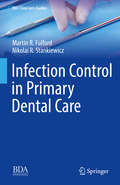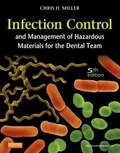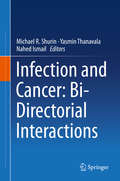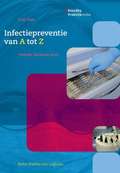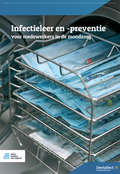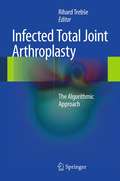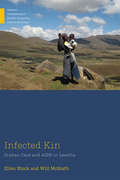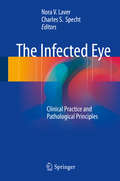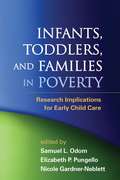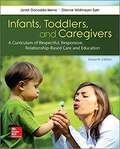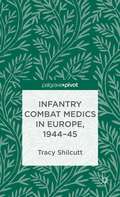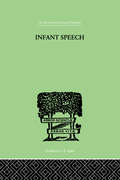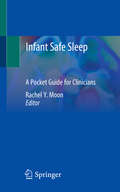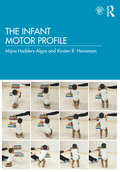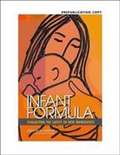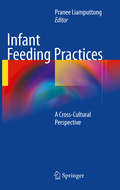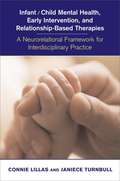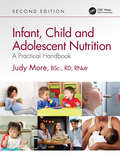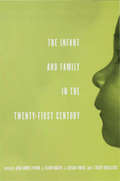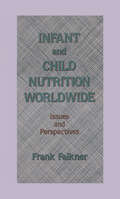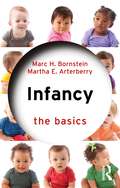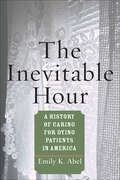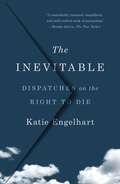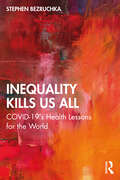- Table View
- List View
Infection Control in Primary Dental Care (BDJ Clinician’s Guides)
by Martin R. Fulford Nikolai R. StankiewiczThis book is an easy-to-use guide to all aspects of infection control and decontamination that will support the implementation of effective measures for risk reduction in dental practice. Among the topics addressed are the principles and practicalities of cleaning and sterilizing dental instruments, the role of personal protective equipment, the design and use of decontamination rooms, choice of dental equipment, environmental disinfection, and considerations relating to dental unit water lines. In addition, readers will find an informative and helpful section on the background history and basic science of infection control within dentistry. Infection Control in Primary Dental Care will be very useful for all members of the dental team, including dentists, dental nurses or assistants, dental hygienists, and therapists. The book is illustrated with photographs, diagrams, and tables to aid understanding and encourage good practice. The authors have a background in microbiology and dental practice and have extensive experience of providing advice and guidance to professional colleagues on infection control procedures.
Infection Control and Management of Hazardous Materials for the Dental Team (Fifth Edition)
by Chris H. Miller Charles John PalenikEmphasizing patient safety and infection prevention in the dental office, Infection Control and Management of Hazardous Materials for the Dental Team, 5th Edition, covers everything from basic concepts in microbiology to protocols for clinical asepsis. Clear, step-by-step instructions make it easy for you to perform safety procedures and use the supplies and equipment needed to prevent the spread of infectious disease. New to this edition are full-color photographs and four new chapters on emerging topics. Written by oral biology and infection control expert Chris Miller, this resource is a must read for every member of the dental team. Comprehensive coverage follows dental assisting and dental hygiene curricula requirements for infection control, ensuring that you learn essential principles and procedures for clinical competence. Easy-to-follow, step-by-step procedures are provided for skills that dental team members must master, each presented with a goal, materials, chronological steps, and rationales for the performance of each step. Key terms begin each chapter and are highlighted within text discussions and defined in a back-of-book glossary. Summary tables and boxes make study easier by highlighting key concepts and procedures. Review questions ensure your comprehension of the material with 5 to 20 multiple-choice questions at the end of each chapter. Practical appendices offer easy access to the most significant regulatory agency rules and recommendations for infection control. Student resources on the Evolve companion website include practice exercises plus review questions and quizzes. NEW! Full-color photographs show the latest equipment, supplies, and procedures and accurately depict concepts in microbiology and the nature of infectious disease. Four NEW chapters cover changing and emerging topics and trends in infection control, including Hand Hygiene, Preventing Sharps Injuries, General Office Asepsis, and Cross-contamination Between Work and Home. NEW! Case scenarios on the Evolve companion website examine an infection control incident along with its potential consequences, possible preventive measures, and related recommendations and regulations. UPDATED content includes new areas such as technology involving surface and equipment asepsis, dental water unit air quality, and green infection control.
Infection and Cancer: Bi-Directorial Interactions
by Michael R. Shurin Yasmin Thanavala Nahed IsmailThis unique book summarizes current knowledge on co-development of infectious diseases and cancer. It provides an overview of the complex and unique role of the immune system, inflammation, tumor-mediated immunosuppression and infection-induced immunomodulation in cancer and infection progression. Chapters are organized into themed parts, beginning with a look at the historical perspective of human tumor viruses, then aspects and examples of infection-related cancers and cancer-associated infections. The work discusses how cancer- and infection-associated immune responses interact in a bi-directorial fashion and how these interactions may evolve during both disease progression and in response to therapy. The phenomenon of independent development of cancer and infection in the same host, known as comorbid cancer-infection progression, is explored. Understanding the complex pathways involved in the progression of infection and cancer will allow the prevention of the development of certain types of cancer, as well as advancing prophylactic anti-cancer vaccines. Readers of this work will discover innovative approaches for multidisciplinary projects, focusing on the design of original therapeutic modalities for cancer therapy. The book will therefore be particularly valuable to scholars interested in cancer immunology and researchers and clinicians in the field of basic and applied immunobiology and microbiology.
Infectiepreventie van A tot Z
by D. M. VoetPraktijkgerichte vakinforamtie voor de moderne tandartsassistent. De reeks is te gebruiken voor scholing, het opfrissen van kennis en als naslagwerk.
Infectieleer en -preventie: Voor medewerkers in de mondzorg
by D.M. VoetInfectieleer en -preventie is geschikt voor medewerkers in de mondzorg die met patiëntenzorg of instrumentarium in aanraking komen. Het geeft op heldere en praktijkgerichte wijze inzicht in de thema's die belangrijk zijn in het voorkomen van infecties. Dit boek is geschreven voor (toekomstige) tandartsassistenten, maar is ook zeer geschikt als leerboek of naslagwerk op het gebied van gezonde praktijkvorming voor alle andere medewerkers in de mondzorg.
Infected Total Joint Arthroplasty
by Rihard TrebšeThere are a variety of protocols that are used in infected total joint arthroplasty. This book outlines and details the best possible course of treatment and formulate custom algorithms for every possible case, based on current evidence. It reviews current concepts and "recipes" for the diagnostic and therapeutic procedures (surgical and antibiotic) based on the type of implant, infection and the patient. This book is an essential resource on infected total joint arthroplasty, containing a series of logical and highly detailed instructions that will serve to educate orthopedic surgeons operating in this field on the best approaches, according to detailed and careful research conducted over the last decade.
Infected Kin: Orphan Care and AIDS in Lesotho (Medical Anthropology)
by Ellen Block Will McGrathAIDS has devastated communities across southern Africa. In Lesotho, where a quarter of adults are infected, the wide-ranging implications of the disease have been felt in every family, disrupting key aspects of social life. In Infected Kin, Ellen Block and Will McGrath argue that AIDS is fundamentally a kinship disease, examining the ways it transcends infected individuals and seeps into kin relations and networks of care. While much AIDS scholarship has turned away from the difficult daily realities of those affected by the disease, Infected Kin uses both ethnographic scholarship and creative nonfiction to bring to life the joys and struggles of the Basotho people at the heart of the AIDS pandemic. The result is a book accessible to wide readership, yet built upon scholarship and theoretical contributions that ensure Infected Kin will remain relevant to anyone interested in anthropology, kinship, global health, and care. Supplementary teaching materials are available at: https://www.csbsju.edu/sociology/anthropology-teaching-resources/useful-resources/infected-kin-teaching-resources
The Infected Eye
by Nora V. Laver Charles S. SpechtThis book discusses the diagnosis and treatment of common ocular infections with the aim of clearly explaining current recommended clinical practice in order to aid physicians involved in the care of patients. Relevant pathological principles are described to provide a basis for the understanding of these disorders. The epidemiology of infection as a class of ocular disease and the pathological effects of infectious processes in tissue are discussed in an introductory section. These fundamentals are explained and reinforced with tables and selected illustrations of tissue pathology. Leading clinical specialists then describe the diagnosis and treatment of infections of the conjunctiva, cornea, intraocular tissues, orbit, eyelids, and ocular adnexa as they present in adults and children. Illustrative tables and algorithms enhance the discussion, making key principles accessible to the busy clinician. The book contains useful appendices that summarize relevant microbiological techniques, recommendations for specimen collection and transport, and current principles for the appropriate use of antibiotics.
Infants, Toddlers, and Families in Poverty: Research Implications for Early Child Care
by Samuel Odom Elizabeth P. PungelloIdentifying factors related to poverty that affect infants, toddlers, and their families, this book describes promising early child care and intervention practices specifically tailored to these children and families' needs. Leading authorities from multiple disciplines present cutting-edge research and discuss the implications for practice and policy. Contributors review salient findings on attention, memory, language, self-regulation, attachment, physical health, family processes, and culture. The book considers the strengths and limitations of existing early intervention services for diverse populations and explores workable ways to improve them.
Infants Toddlers and Caregivers
by Janet Gonzalez-Mena Dianne Widmeyer EyerInfants, Toddlers, and Caregivers is an ideal introduction to care and education in the first three years of life, featuring a respectful approach inspired by field pioneers Magda Gerber and Dr. Emmi Pikler. The program provides practical information based on theoretical and research foundations that students can implement in a variety of infant and toddler settings. With the impacts of school readiness and technology in early childhood education today, this program focuses on the value of free play, the development of self-reliance, and the importance of responsive, respectful interactions. The Connect course for this offering includes SmartBook, an adaptive reading and study experience which guides students to master, recall, and apply key concepts while providing automatically-graded assessments.
Infantry Combat Medics in Europe, 1944–45
by Tracy ShilcuttMedics learned quickly to ignore standing operating procedures in order to save, lives but tensions within infantry units created a paradoxical culture of isolation and acceptance. This groundbreaking work examines training and combat experiences of soldiers working in Battalion Aid Stations and those who went as aid men to the line companies.
Infant Speech: A STUDY OF THE BEGINNINGS OF LANGUAGE (International Library Of Psychology Ser. #Vol. 77)
by Lewis, M M"First Published in 1999, Routledge is an imprint of Taylor & Francis, an informa company."
Infant Safe Sleep: A Pocket Guide for Clinicians
by Rachel Y. MoonThis book is a practical, comprehensive look at safe sleep for infants, including safe sleep for infants with co-occurring medical conditions. Currently there is a dearth of resources on this topic for general pediatricians and other clinicians who provide health care to infants. The only evidence-based information about sudden infant death syndrome (SIDS) and other sleep-related infant deaths is published in policy statements and technical reports published by the American Academy of Paediatrics. However pediatricians, public health professionals, and others who provide health care, anticipatory guidance, and/or health education to parents often have difficulty translating the policy recommendations to practice.This book gives guidance and suggestions for clinicians for counseling parents and other caretakers of infants. It discusses common barriers to adherence, as well as approaches that are evidence-based or use behavior change theory. Chapters focus on important aspects of the sleep environment, evaluating commonly sold sleep products, and common sleep practices, including roomsharing and bedsharing. There is also a thorough discussion of SIDS pathophysiology, and a closing chapter on grief and counselling families after a loss.Each chapter follows an organizational structure, to promote consistency and ensure this remains a practical, easy-to-use tool. Chapters open with a clinical vignette and close with a discussion of frequently encountered questions, and clinical pearls and pitfalls. Infant Safe Sleep is a valuable resource for pediatricians, nurse practitioners, physician assistants as well as social workers, allied health professionals, public health practitioners, health educators, WIC nutritionists and child care providers.
The Infant Motor Profile
by Mijna Hadders-Algra Kirsten R HeinemanThe Infant Motor Profile is a practical manual on a new, evidence-based method to assess infant motor behaviour. Not only looking at what milestones the infant has reached, but also paying attention to the quality of motor behaviour – how the infant moves – this text provides professionals involved in the care of infants at risk of developmental disorders with information on five domains of motor behaviour: variation, adaptability, symmetry, fluency, and performance. Backed up by extensive, up-to-date research, it includes percentile curves so that professionals can easily interpret the infants’ scores. The profile created from the assessment informs about the infant’s current condition and their risk of developmental disorders, as well as providing suggestions for early intervention, tailored to the strengths and limitations of the infant. Used over time, it can be an excellent instrument to monitor the infant’s developmental progress. Illustrated with numerous figures and accompanied by a website hosting over 100 video clips, this text is an essential read for professionals in developmental paediatrics, including paediatric physiotherapists, occupational therapists, developmental paediatricians, neuropaediatricians, and paediatric physiatrists.
Infant Mortality and Working-Class Child Care, 1850-1899
by Melanie ReynoldsInfant Mortality and Working-Class Child Care, 1850-1899 unlocks the hidden history of working-class child care during the second half of the nineteenth century, seeking to challenge those historians who have cast working-class women as feckless and maternally ignorant. By plotting the lives of northern women whilst they grappled with industrial waged work in the factory, in agriculture, in nail making, and in brick and salt works, this book reveals a different picture of northern childcare, one which points to innovative and enterprising child care models. Attention is also given to day-carers as they acted in loco parentis and the workhouse nurse who worked in conjunction with medical paediatrics to provide nineteenth-century welfare to pauper infants. Through the use of a new and wide range of source material, which includes medical and poor law history, Melanie Reynolds allows a fresh and new perspective of working-class child care to arise.
Infant Formula: Evaluating The Safety Of New Ingredients
by Institute of Medicine of the National AcademiesInfant formulas are unique because they are the only source of nutrition for many infants during the first 4 to 6 months of life. They are critical to infant health since they must safely support growth and development during a period when the consequences on inadequate nutrition are most severe. Existing guidelines and regulations for evaluating the safety of conventional food ingredients (e.g., vitamins and minerals) added to infant formulas have worked well in the past; however they are not sufficient to address the diversity of potential new ingredients proposed by manufacturers to develop formulas that mimic the perceived and potential benefits of human milk. This book, prepared at the request of the Food and Drug Administration (FDA) and Health Canada, addresses the regulatory and research issues that are critical in assessing the safety of the addition of new ingredients to infants.
Infant Feeding Practices
by Pranee LiamputtongIt's natural... It's unsightly... It's normal... It's dangerous. To breastfeed or not? For millions of women around the world, this personal decision is influenced by numerous social, cultural, and health factors. Infant Feeding Practices is the first book to delve into these factors from a global perspective, revealing striking similarities and differences from country to country. Dispatches from Asia, Australia, Africa, the U.K., and the U.S. explore as wide a gamut of salient issues affecting feeding practices as traditional beliefs about colostrums, "breast is best" campaigns, partner attitudes, workplace culture, direct government intervention, and the pressure to be a "good mother." Throughout these informative pages, women are seen balancing innovation and tradition to nurture healthy, thriving babies. A sampling of topics covered: * Policy versus practice in infant feeding. * Infant feeding in the age of AIDS. * Managing the lactating body: the view from the U.S. * Motherhood, work, and feeding. * The effects of migration on infant feeding. * From breastfeeding tradition to optimal breastfeeding practice. Infant Feeding Practices is a first-of-its-kind resource for researchers and practioners in maternal and child health, public health, global health, and cultural anthropology seeking empirical findings and culturally diverse information on this sensitive issue.
Infant/Child Mental Health, Early Intervention, and Relationship-Based Therapies: A Neurorelational Framework For Interdisciplinary Practice
by Connie Lillas Janiece TurnbullWhen early interventions with children fail, clinicians wonder: How could things have been different? The answers seem obvious at first, but a little reflection begins to unveil just how complicated this question really is. Who should have been included in the treatment? With what professionals and using what approaches? When should intervention have occurred? Each question involves a spectrum of both personal and societal issues, which is perhaps why problems that are so widely acknowledged remain so widely ignored. Often, a family is not aware that their story could have had a different ending. So, in response to the critical need for a more cohesive system of care for our youngest patients, this book presents a conceptual framework for interdisciplinary collaboration. Examining the issues of infant mental health and early intervention from a brain-based perspective--one that cuts across all domains--addresses the need for individual practitioners to incorporate the whole picture in relation to their part in assessing and intervening with each individual child and parent, and provides a global framework for team collaboration.
Infant, Child and Adolescent Nutrition: A Practical Handbook
by Judy MoreInfant, Child and Adolescent Nutrition: A Practical Guide, Second Edition, is an evidence-based, practical guide introducing readers to the theory behind optimal child nutrition. Containing practical advice on how to put that theory into practice, this new edition facilitates learning through case studies, key points, and learning activities. Divided into seven sections, chapters cover prenatal nutrition and nutrition throughout childhood from preterm babies to adolescents up to the age of 18. Sections throughout focus on topics ranging from nutrient requirements, balanced eating patterns and common problems to cultural influences on food choices and guidelines on assessing growth and dietary intakes. Prevention and management of obesity and allergies are covered in separate chapters. The first 1000 days are given particular consideration with chapters on diets for preconception, pregnancy, milk feeding and complementary feeding during infancy. The chapter on nutritional treatments covers common conditions such as diabetes and Crohn’s disease, as well as more intricate feeding regimes and tube feeding required for children with rarer diseases and syndromes. New in this second edition are: · Changes in in food allergy prevention and oral immunotherapy treatments. · Causes and management strategies to deal with fussy and selective eating in toddlers. · The importance of iodine in diets before and during pregnancy to improve children’s cognitive abilities. · Updated recommendations on vitamin D supplementation. This second edition is an essential reading for students taking courses in nutrition and paediatric healthcare. It serves as a useful reference for individuals responsible for the nutritional intakes of children in primary care and community settings including early years practitioners, midwives, health visitors, school nurses and governors, social workers, paediatricians and general practitioners. About the Author Judy More BSc, RD, RN is a Paediatric Dietitian, Honorary Lecturer at the University of Plymouth, UK and Director of Child-nutrition.co.uk Ltd, London, UK.
The Infant and Family in the Twenty-First Century (The Mentor Series (IACAPAP))
by T. Berry Brazelton J. Kevin Nugent João Gomes-Pedro J. Gerald YoungFirst Published in 2003. Routledge is an imprint of Taylor & Francis, an informa company.
Infant and Child Nutrition Worldwide: Issues and Perspectives
by Frank FalknerThis volume provides a contemporary and historical overview of infant nutrition in Europe, North America, and the Third World. It emphasizes the important role that good nutrition, appropriate health care, and a caring environment play in promoting healthy physical and social growth in children. Issues covered include breast feeding, maternal undernutrition and reproductive performance, weaning, and the social and pyschological factors of breast feeding. The book will serve as an excellent guide for nutritionists, pediatricians, health professionals and others involved in child welfare worldwide.
Infancy: The Basics (The Basics)
by Marc H. Bornstein Martha E. ArterberryInfancy: The Basics offers an introduction to the developmental science behind the fascinating world of infant development. This book takes the reader from before birth through the moment infants come into the world seemingly unable to do much but eat, eliminate, and sleep, and across the few short, incredible years, to when infants are walking, talking, thinking humans with clear preferences, wishes, and dreams, having already forged strong long-lasting relationships. Dispelling common myths and misconceptions about how infants’ perception, cognition, language, and personalities develop, this accessible evidence-based book takes a novel whole-child approach and provides insight into the joint roles of nature (biology) and nurture (experiences) in infant development, how to care for babies to give them the best start in life, and what it means for infants to become thinking communicating social partners. Topics in this book are covered with an eye firmly fixed on how infants’ first years set the stage for the rest of their lives. By helping us understand infants, experts Marc H. Bornstein and Martha E. Arterberry give us the opportunity to learn about the resiliency of our species and the many different contexts in which families rear infants. They cover key topics, including how babies are studied scientifically, prenatal development and the newborn period, how infants explore and understand the world around them, how infants begin to communicate, how infants develop an emotional life, personality, and temperament, how infants build relationships, and how parents succeed in bringing up babies in challenging circumstances. This concise clear guide to the years from before birth to 3 is for students of developmental psychology, pediatric medicine and nursing, education, and social work. It also for all parents and professionals caring for infants, who want to understand the secret world of infancy.
The Inevitable Hour: A History of Caring for Dying Patients in America
by Emily K. AbelChanges in health care have dramatically altered the experience of dying in America.At the turn of the twentieth century, medicine’s imperative to cure disease increasingly took priority over the demand to relieve pain and suffering at the end of life. Filled with heartbreaking stories, The Inevitable Hour demonstrates that professional attention and resources gradually were diverted from dying patients. Emily K. Abel challenges three myths about health care and dying in America. First, that medicine has always sought authority over death and dying; second, that medicine superseded the role of families and spirituality at the end of life; and finally, that only with the advent of the high-tech hospital did an institutional death become dehumanized. Abel shows that hospitals resisted accepting dying patients and often worked hard to move them elsewhere. Poor, terminally ill patients, for example, were shipped from Bellevue Hospital in open boats across the East River to Blackwell’s Island, where they died in hovels, mostly without medical care. Some terminal patients were not forced to leave, yet long before the advent of feeding tubes and respirators, dying in a hospital was a profoundly dehumanizing experience.With technological advances, passage of the Social Security Act, and enactment of Medicare and Medicaid, almshouses slowly disappeared and conditions for dying patients improved—though, as Abel argues, the prejudices and approaches of the past are still with us. The problems that plagued nineteenth-century almshouses can be found in many nursing homes today, where residents often receive substandard treatment. A frank portrayal of the medical care of dying people past and present, The Inevitable Hour helps to explain why a movement to restore dignity to the dying arose in the early 1970s and why its goals have been so difficult to achieve.
The Inevitable: Dispatches on the Right to Die
by Katie EngelhartA riveting, incisive, and wide-ranging book about the Right to Die movement, and the doctors, patients, and activists at the heart of this increasingly urgent issue. More states and countries are passing right-to-die laws that allow the sick and suffering to end their lives at pre-planned moments, with the help of physicians. But even where these laws exist, they leave many people behind. The Inevitable moves beyond margins of the law to the people who are meticulously planning their final hours—far from medical offices, legislative chambers, hospital ethics committees, and polite conversation. It also shines a light on the people who help them: loved ones and, sometimes, clandestine groups on the Internet that together form the “euthanasia underground.”Katie Engelhart, a veteran journalist, focuses on six people representing different aspects of the right to die debate. Two are doctors: a California physician who runs a boutique assisted death clinic and has written more lethal prescriptions than anyone else in the U.S.; an Australian named Philip Nitschke who lost his medical license for teaching people how to end their lives painlessly and peacefully at “DIY Death” workshops. The other four chapters belong to people who said they wanted to die because they were suffering unbearably—of old age, chronic illness, dementia, and mental anguish—and saw suicide as their only option. Spanning North America, Europe, and Australia, The Inevitable offers a deeply reported and fearless look at a morally tangled subject. It introduces readers to ordinary people who are fighting to find dignity and authenticity in the final hours of their lives.
Inequality Kills Us All: COVID-19's Health Lessons for the World
by Stephen BezruchkaThe complex answer to why the United States does so poorly in health measures has at its base one pervasive issue: The United States has by far the highest levels of inequality of all the rich countries. Inequality Kills Us All details how living in a society with entrenched hierarchies increases the negative effects of illnesses for everyone. The antidote must start, Stephen Bezruchka recognizes, with a broader awareness of the nature of the problem, and out of that understanding policies that eliminate these inequalities: A fair system of taxation, so that the rich are paying their share; support for child well-being, including paid parental leave, continued monthly child support payments, and equitable educational opportunities; universal access to healthcare; and a guaranteed income for all Americans. The aim is to have a society that treats everyone well—and health will follow.
